Impact-Site-Verification: bf05467d-21a6-4d09-9416-92c52b07e6a5
Cleaning a toilet is pretty simple since toilets are always made out of the same material, but what about your toilet seat? Toilet seats can come in many different materials and there are some things you shouldn’t do when cleaning your seat. So, how do you clean a toilet seat?
To clean a toilet seat, take a paper toilet or cleaning rag and wet it with a disinfectant solution. Wipe down the seat with the disinfectant. Never use bleach, aerosols, or vinegar on your toilet seat or it could cause yellow stains or damage the glossy finish.
There are a few things to keep in mind depending on what material your toilet seat is made out of. We’ll cover how to clean plastic, enameled wood, and wood veneer toilet seats. Let’s start cleaning!
Table of Contents
How to Clean a Plastic Toilet Seat and Wood Enamel Toilet Seat
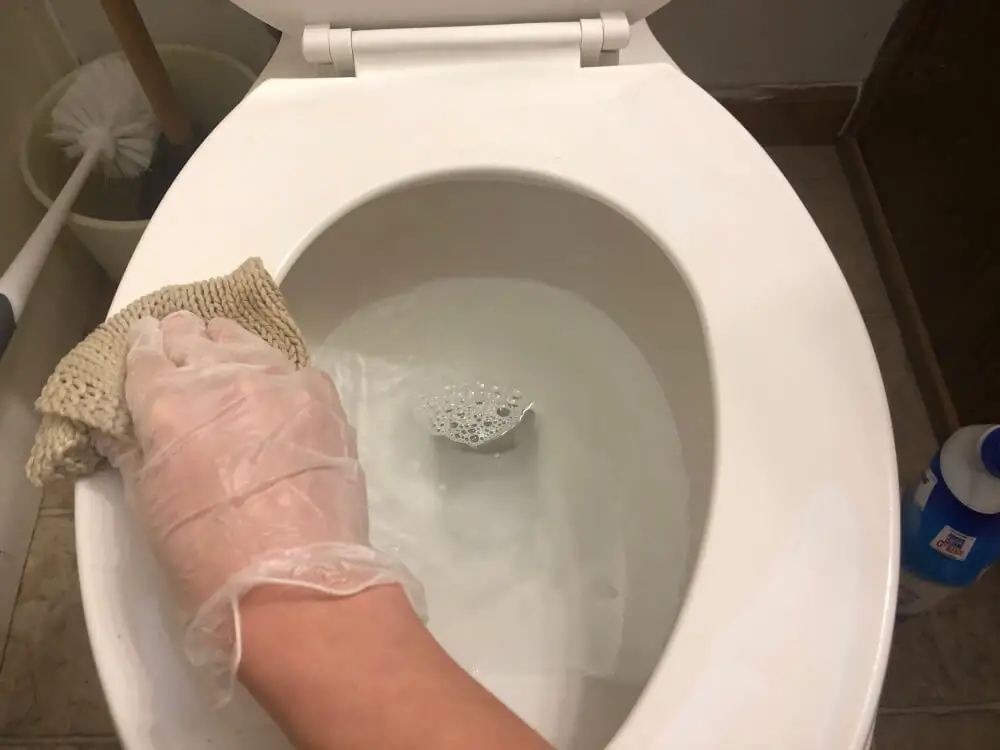
Let’s start with plastic and enameled wood toilet seats. These are pretty common, most homes have either plastic or an enameled wood toilet seat.
I grouped these two types of seats because the cleaning guidelines for them are the same.
A plastic seat is light and has flex if you try and bend it. Enameled wood has a wooden core that’s been covered in a, usually white, enamel coating.
An enameled wood seat is heavier but will be white just like a plastic seat. If your seat is white and light, it’s plastic, if it’s white and heavy it’s probably enameled wood.
Check out our other post for a full breakdown of wood vs plastic toilet seats.
Time to get to the cleaning.
Materials Needed
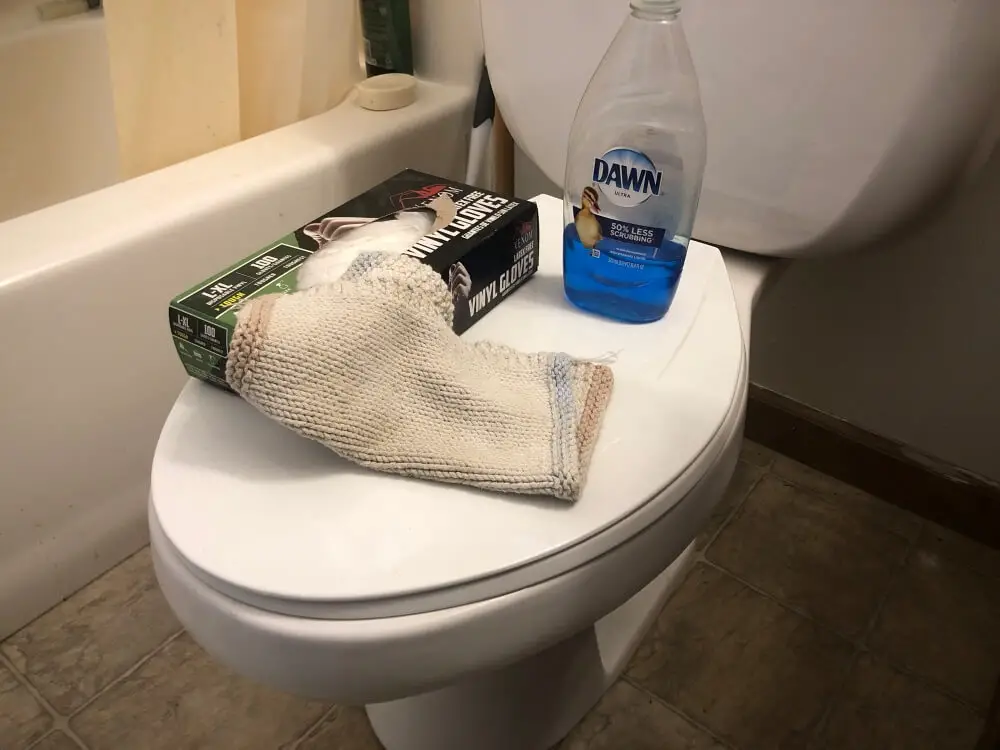
To clean a plastic seat and an enameled wood seat, you’ll need the following things
- A pair of gloves (rubber, vinyl, or kitchen gloves, just something to protect your skin)
- A bleach-free cleaner (antibacterial soap like Dawn or a disinfectant wipe like Lysol or Clorox)
- Paper towels or a cleaning rag
- A scrub brush (you’ll only need this if the toilet seat bolts are rusty)
I would recommend cleaning your toilet bowl before cleaning your seat, that way if you accidentally get any of the toilet bowl cleaners on the seat you can clean it off quickly.
When choosing a cleaner for a plastic toilet seat make sure it doesn’t have any bleach in it, bleach will cause yellow stains on plastic. On a wood enamel seat, bleach will cause the finish to flake off and peel.
Either way, it’s not a good look for the toilet seat, so it’s best to avoid bleach.
Most toilet bowl cleaner has bleach in it which is why you should try not to get it on your seat and make sure you clean it off quickly if you do.
Also, don’t use a disinfectant spray, specifically an aerosol spray. The chemicals used in aerosol sprays can cause the same yellowing effect or other damage to your toilet seat.
Once you’ve gathered everything you need, time to get to the nitty-gritty.
Clean Your Toilet Seat
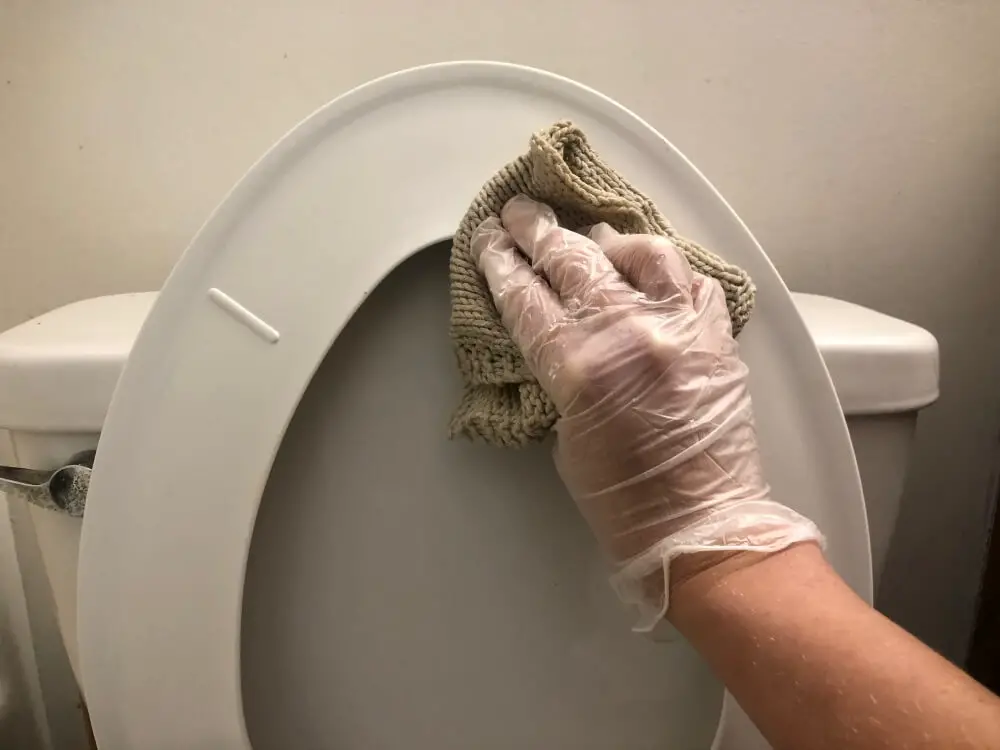
To clean your toilet seat, make a mix of warm water and your chosen soap, if you’re using a cleaning wipe then you can skip this step.
Then, wipe down all surfaces of the toilet seat. Once your seat has been thoroughly cleaned, get a rag wet with just clean water.
Wipe down the seat to rinse all the soap residue off your toilet seat. Leave the seat down and the lid up to allow your seat to dry properly.
The last thing you’ll want to check is to see if your toilet seat bolts are rusty. If they are, you can either scrub them to get the rust off or replace them or give them. Follow our tutorial here for how to replace a toilet seat.
How to Clean a Wood Veneer Toilet Seat
Wood veneer is the type of toilet seat that looks like wood. It has a wooden core seat that is covered in strips of wood veneer so you can see the wood grain.
This veneer is then covered in a clear coating to protect to wood from moisture. When cleaning a wood veneer seat, you need to use a cleaner that will not damage this coating.
If the clear coating is damaged, the wood could be exposed to moisture which can cause the seat to warp or even mold.
So, let’s talk about what kind of cleaner you should use and what other materials you need.
Materials Needed
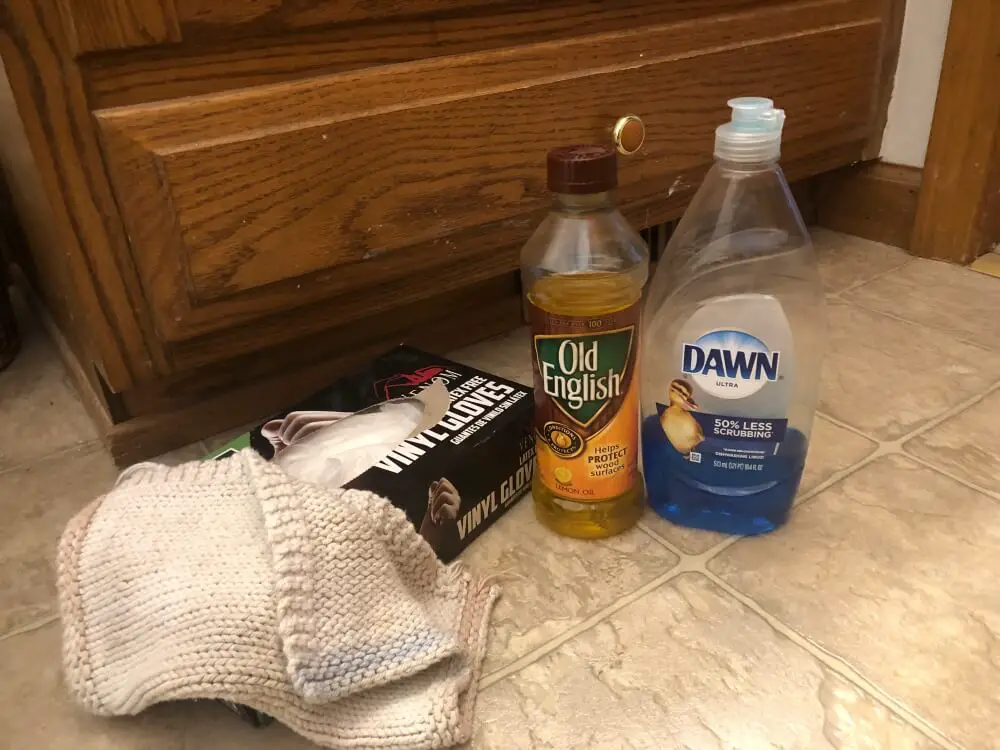
The materials you need for a wood veneer seat are about the same as for a plastic and a wood enamel seat.
- A pair of gloves (rubber, vinyl, or kitchen gloves, just something to protect your skin)
- A gentle antibacterial soap such as hand soap or dish soap (bleach-free)
- A wood finishing oil
- Paper towels or a cleaning rag
Let’s talk about the soaps real quick. First, you should only use a gentle antibacterial soap such as Dawn or a hand soap.
This is gentle enough that it won’t damage the finish but should kill any bacteria present on the seat. Make sure your cleaning products do not contain bleach or chlorine bleach as this can damage the clear coating and cause it to flake off.
Additionally, don’t use toilet bowl cleaners because most of them contain bleach. If you get toilet cleaner on your seat, make sure you clean it off quickly so it doesn’t damage the finish.
Second, I listed a wood finishing oil on here. A wool oil is used to treat wood furniture, wood floors and, yes, wood toilet seats.
Wood oil will help protect wood and basically keep your seat looking shiny and new.
Clean Your Toilet Seat
To clean your wooden toilet seat, make a mix of hot water and mild soap. Use a rag to wipe down all surfaces of your toilet seat.
Once clean, use a rag with plain clean water and wipe down your seat to rinse off all soap residue. Leave the seat down and the lid up so your seat can fully dry.
If you want to treat your seat with wood oil, put it on after you rinse the other soap off and the seat is fully dry.
Then use a dry rag with just a splash of wood oil and wipe down the seat with the wood oil.
Now you have a nice clean toilet seat that looks shiny and new.
How to Remove Stains from a Toilet Seat
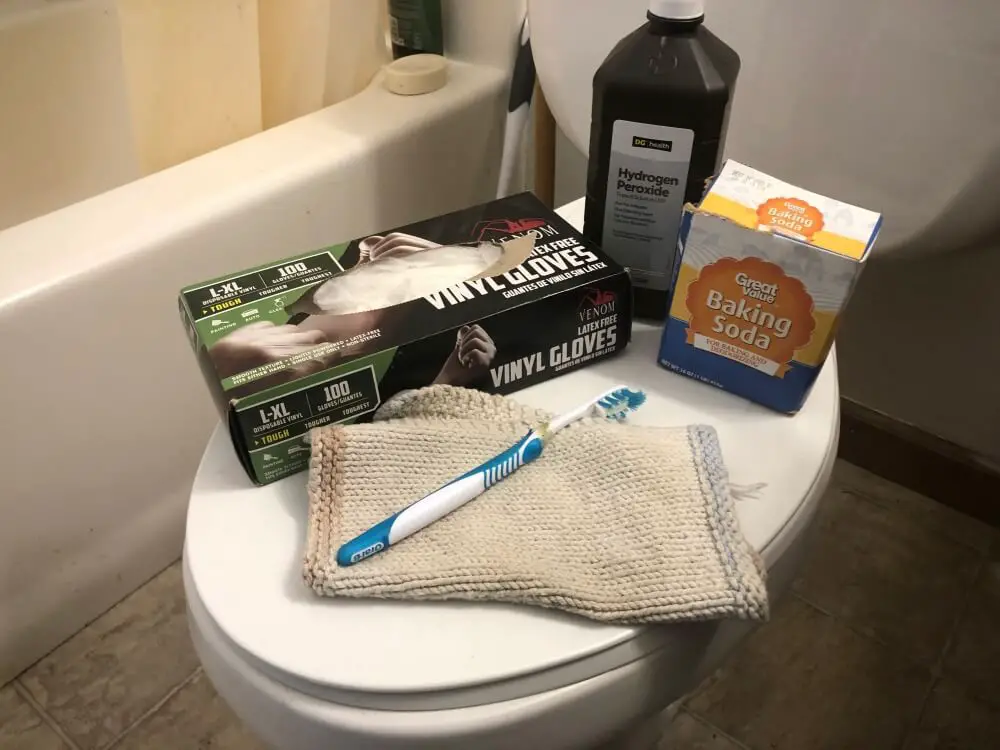
A stained toilet seat can be super annoying, but some stains can be removed easily.
Several things can cause yellow stains on a toilet seat such as bleach, rust, and urine. There are three methods you can try to remove stains from your toilet.
The first method is scrubbing it with hydrogen peroxide, the second method is making a baking soda paste and last but not least, you can use WD-40 to remove tough stains caused specifically by rust.
For all of these methods, I would advise using rubber gloves to protect your skin.
Let’s get to it!
1. Hydrogen Peroxide
This is the lowest cost and easiest method so you should start with it and see if it works.
Put hydrogen peroxide in a spray bottle and spray it onto the surface with the yellow stains. Then, use a soft scrub brush such as a toilet brush or an old toothbrush and scrub the area with a circular motion.
It might take some elbow grease and time. Reapply and scrub the stains and see if there is any difference in the stain.
Hydrogen peroxide can lift bleach stains and help with urine stains.
If the stains don’t budge, try the next method.
2. Baking Soda Paste
This method is exactly what it sounds like, create a paste with baking soda and water. The paste should be thick enough to stick to the toilet seat surface and stay when the seat is upright.
Poppies Cleaning Service recommends mixing 1/4 cup of baking soda with about 50 mL of water. Add more water or more baking soda as needed to create a good paste.
I have seen some people recommend mixing baking soda with white vinegar, but you shouldn’t use vinegar on a toilet seat because it can dull the glossy finish on the seat.
Spread this paste onto the toilet stains and allow it to sit for around 10 minutes. Then, use a soft scrub brush that’s been wetted and scrub the areas that have baking soda on them.
This should get the more stubborn stains out, especially urine stains. Both of these methods can help remove rust stains as well, but if the rust stains still won’t come out, then there’s one last thing you can try.
3. WD-40
Believe it or not, WD-40 is great at removing rust stains and mineral deposits from both your toilet bowl and your toilet seat.
WD-40 can be expensive which is why you should try this method as a last resort. You can also use WD-40 to clean a rusty water line from your toilet bowl. Check out my other post all about cleaning a toilet with WD-40.
To clean your seat with WD-40, spray the area with the stains with the WD-40. Scrub the areas with a soft scrub brush.
Don’t worry if nothing is happening yet, WD-40 needs water to work its magic. Use a spray bottle full of water and spray the areas you just scrubbed.
Then, scrub them again if needed. If your stains are caused by rust, you should see the stain melting away.
If none of the above methods remove your stains, it might be time to replace your toilet seat.
Related Questions
Can You Clean a Toilet With WD-40?
You can clean a toilet with WD-40. WD-40 is a great way to get rust stains out of your toilet bowl. I wasn’t convinced it was possible at first but I did an experiment and WD-40 does a great job getting hard water stains out. Check out my other post all about to see pictures of the results.
Can You Use Clorox or Lysol Wipes on a Toilet Seat?
You can use a disinfecting wipe on toilet seats as long as they don’t contain bleach. Bleach can cause yellow discoloration on plastic and enameled wood and can damage the protective coating on wood veneer seats. You shouldn’t use disinfectant wipes on a wood veneer seat if the wood beneath the coating is exposed.
